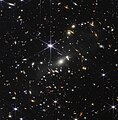Usòrò:Webb's First Deep Field.jpg

Otu nyochaa a ha:587 × 599 piksels Ndị ọzọ mkpebi:235 × 240 piksels | 470 × 480 piksels | 753 × 768 piksels | 1,003 × 1,024 piksels | 2,007 × 2,048 piksels | 4,537 × 4,630 piksels.
Failụ si na nke mbu (4,537 × 4,630 pixel, ívù akwukwo orunótu: 16.43 MB, MIME nke: image/jpeg)
Ịta nke usòrò
Bìri èhì/ogè k'ị hụ òtù ụ̀fa dị̀ m̀gbè ahụ̀.
| Èhì/Ogè | Mbọ-aka | Ógólógó na asaá | Òjìème | Nkwute | |
|---|---|---|---|---|---|
| dị ùgbu â | 12:14, 22 Septemba 2022 |  | 4,537 × 4,630 (16.43 MB) | Habitator terrae | better quality |
| 22:54, 11 Julaị 2022 |  | 4,537 × 4,630 (1.86 MB) | Habitator terrae | {{JPEG version of TIF}} {{Information |description={{en|1=NASA’s James Webb Space Telescope has produced the deepest and sharpest infrared image of the distant universe to date. Known as Webb’s First Deep Field, this image of galaxy cluster SMACS 0723 is overflowing with detail. Thousands of galaxies – including the faintest objects ever observed in the infrared – have appeared in Webb’s view for the first time. This slice of the vast universe is approximately the size of a grain of sand hel... |
Ojiji faịlụ
Ihe ndị na-eso ihe eji Ihu akwụkwọ eme na faịlụ a:
Ejiji failụ zụrụ ọha
Wikis ndi a edeputara na eji kwa failụ a:
- Ihe eji na ar.wikipedia.org
- بوابة:علم الفلك
- مقراب جيمس ويب الفضائي
- أعمدة الخلق
- مركز غودارد لرحلات الفضاء
- وكالة الفضاء الكندية
- ويكيبيديا:صور مختارة/الفضاء والكون/نظرة إلى الأعلى
- بوابة:علم الفلك/صورة مختارة
- بوابة:علم الفلك/قوالب
- جيمس إدوين ويب
- معهد مراصد علوم الفضاء
- قائمة الحقول العميقة
- قالب:مقراب جيمس ويب الفضائي
- بوابة:علم الكواكب خارج المجموعة الشمسية/قوالب
- بوابة:علم الكواكب خارج المجموعة الشمسية
- درع شمسي لمقراب جيمس ويب الفضائي
- كاميرا نيركام
- كاميرا ميري (للأشعة تحت الحمراء المتوسطة)
- مطياف نير
- الحقل العميق الأول لويب
- عنقود مجرات SMACS 0723
- ويكيبيديا:ترشيحات الصور المختارة/الحقل العميق الأول لويب
- ويكيبيديا:صورة اليوم المختارة/أغسطس 2022
- قالب:صورة اليوم المختارة/2022-08-15
- بوابة:علم الفلك/صورة مختارة/81
- سيرس-93316
- Ihe eji na as.wikipedia.org
- Ihe eji na av.wikipedia.org
- Ihe eji na az.wikipedia.org
- Ihe eji na be.wikipedia.org
- Ihe eji na bg.wikipedia.org
- Ihe eji na bn.wikipedia.org
- Ihe eji na ca.wikipedia.org
- Ihe eji na ckb.wikipedia.org
- Ihe eji na cs.wikipedia.org
- Ihe eji na de.wikipedia.org
Lee more global usage of this file.



